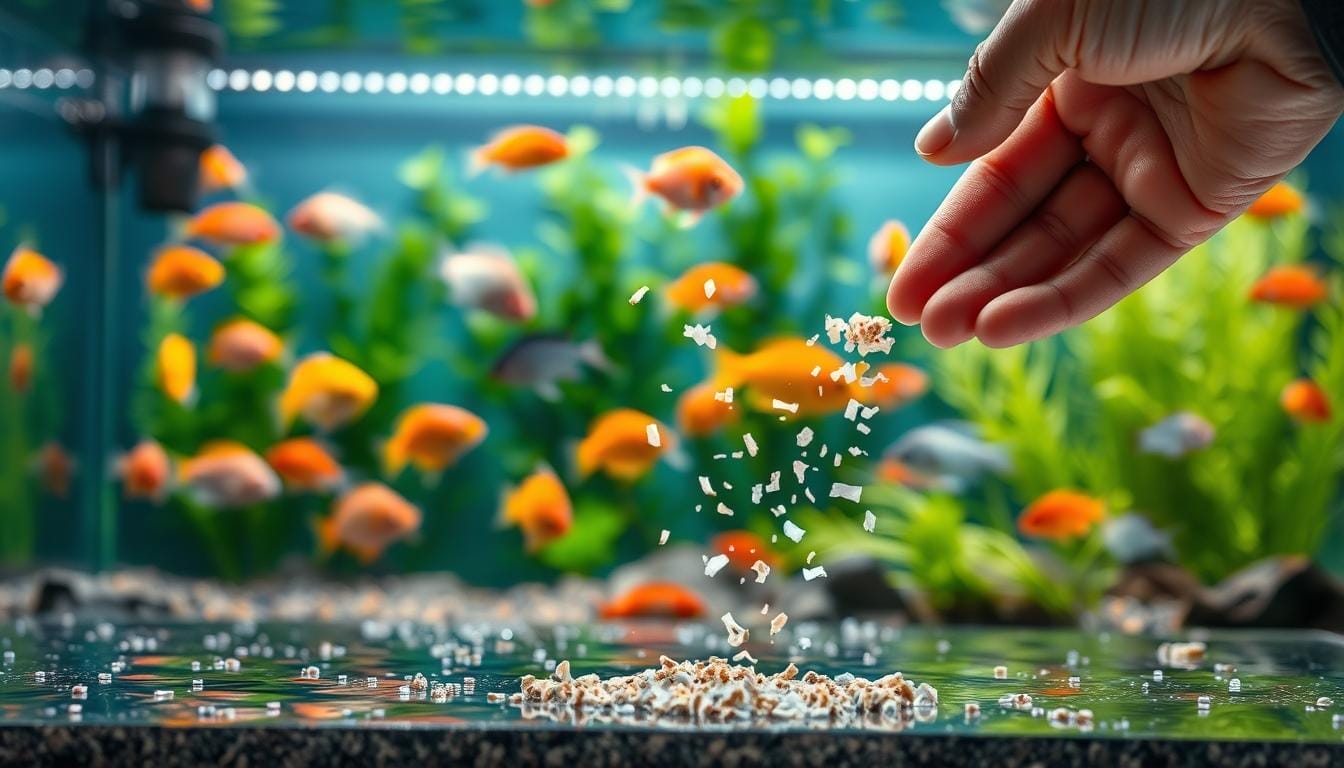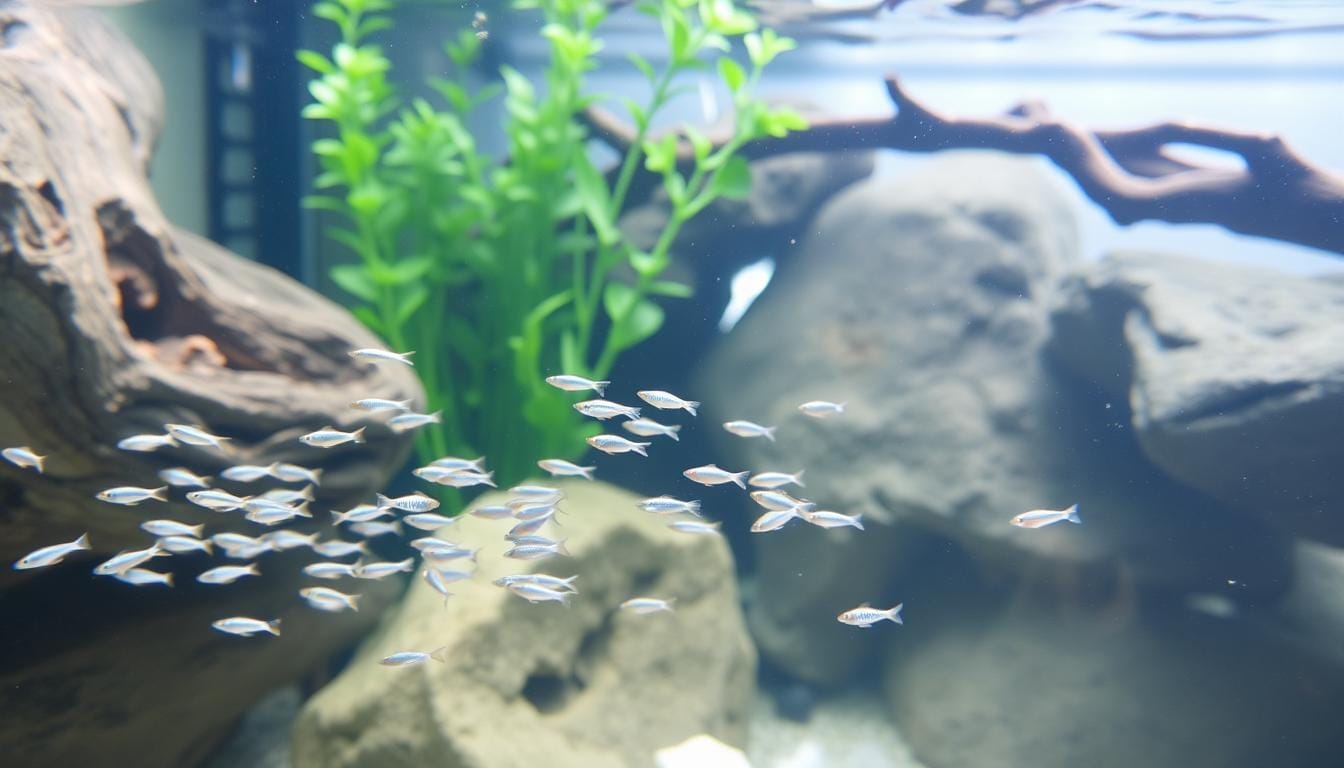
Raising Baby Fish: A Beginner’s Guide to Success

Did you know over 90% of newly hatched aquarium fish don’t survive their first week without proper care? In nature, these fragile creatures face steep odds—but in your tank, you hold the power to dramatically improve their chances. Witnessing tiny fry grow into vibrant swimmers offers unmatched satisfaction, blending science with the magic of new life.
This guide unlocks everything needed to nurture aquatic juveniles, whether you’re planning a breeding project or discovering surprise hatchlings. You’ll learn how to spot breeding behaviors, from egg-laying rituals to subtle physical changes in your aquatic pets. We simplify tank setup tips, feeding routines, and water quality management into actionable steps.
Success hinges on understanding their unique needs. Some species require specialized environments, while others thrive with minimal intervention. Patience becomes your greatest tool as you monitor growth stages and adapt your approach.
By the end, you’ll feel equipped to handle both intentional breeding and unexpected arrivals. Transform your aquarium into a thriving nursery—where careful preparation meets the wonder of life unfolding before your eyes.
Introduction to Aquarium Breeding and Baby Fish Development
Aquatic life astonishes with its diversity—over 30,000 species have developed unique ways to bring new generations into your tank. Recognizing these patterns helps you create ideal conditions, whether caring for egg clusters or free-swimming fry.
Understanding Fish Reproduction Methods
Two primary strategies dominate underwater nurseries. Livebearing species like guppies and mollies give birth to fully formed swimmers, while egg-layers such as tetras deposit delicate eggs in plants or gravel. Did you know male seahorses carry developing young in their pouches? This fascinating exception highlights nature’s creativity.
Egg-laying species often require specific setups. Some build bubble nests at the water’s surface, while others scatter adhesive eggs across decor. Our guide to aquarium fish breeding techniques details how to support these behaviors.
Observing the Miracle of New Life
Watching tiny forms emerge teaches patience and wonder. Livebearers produce fewer but heartier offspring, while egg-layers may release hundreds of fragile hatchlings. Your approach shifts based on these differences—livebearers need dense plant cover, while egg species demand pristine water quality.
Common aquarium favorites like swordtails demonstrate live birth clearly. Their active fry swim instantly, unlike newly hatched angelfish that cling to leaves. Recognizing these traits helps you protect vulnerable stages and celebrate each species’ unique journey.
Creating the Perfect Aquarium Environment
Your aquarium’s layout acts as both nursery and fortress for developing aquatic life. Balancing open swimming space with protective features gives species their best chance to thrive. Let’s explore how to craft habitats that meet specific requirements while keeping water quality pristine.
Setting Up Your Tank with the Right Hiding Spots
Strategic design starts with understanding your species’ instincts. Live plants like java moss offer natural cover, while ceramic caves create safe zones. Position shelters at multiple depths—floor-level hideouts protect bottom-dwellers, while mid-water structures shield free-swimming juveniles.

Surface-floating plants provide shade and reduce stress. For egg-layers, smooth rocks or slate slabs make ideal spawning surfaces. Always leave adequate open areas for water circulation and growth.
Maintaining Water Quality and Parameters
Stable conditions prevent 80% of common breeding challenges. Test water parameters weekly using liquid kits—sudden pH shifts can prove fatal. Most tropical species need temperatures between 76-82°F and neutral acidity.
Install a reliable heater and perform 15-20% water changes twice monthly. For sensitive species, consider drip acclimation when introducing new hatchlings. Remember: consistency matters more than perfection.
Pair mechanical filtration with sponge pre-filters to protect delicate swimmers. Adjust flow rates to match natural habitats—gentle currents for calm-water species, stronger movement for river-dwellers. Your tank becomes life-supporting when every element works in harmony.
Essential Steps for Raising Baby Fish
Your aquarium transforms into a survival arena when new life emerges. Protecting delicate fry from hungry adults becomes your top priority. Simple separation strategies create safe zones where juveniles can grow without becoming someone’s snack.

Using Dividers and Separate Fry Tanks
Adult fish rarely distinguish between food and offspring. Livebearers like guppies might spare their young, but cichlids often view fry as protein snacks. You’ll master two solutions: temporary dividers or dedicated nursery tanks.
Transferring fry requires gentle handling. Never use nets—their mesh can damage fragile fins. Instead, scoop juveniles with a clean cup filled with original tank water. This maintains familiar chemistry and reduces stress during relocation.
Breeding boxes offer budget-friendly protection. These mesh containers hang inside your main tank, letting water flow through while keeping adults out. For larger groups, set up a separate fry tank with:
- Sponge filters (prevents suction accidents)
- Heaters matching original water temperature
- Java moss for hiding and microorganism grazing
Make sure nursery tanks stay cycled using media from established setups. If space allows, choose containers big enough for gradual growth. Regular water testing becomes non-negotiable—developing fry need pristine conditions to thrive.
Identifying and Caring for Pregnant Fish
Spotting pregnancy in aquarium dwellers requires sharp observation skills. While some changes appear obvious, others demand careful tracking over time. Let’s explore how to support expectant swimmers through this critical phase.
Recognizing Pregnancy Signs in Aquarium Fish
Livebearing fish species like guppies reveal pregnancies through abdominal bulges and darkened gravid spots. These markings near the tail intensify 20-40 days after mating—your cue to prepare a maternity tank. Egg-layers show different clues: swollen bellies or jelly-like sacs attached to plants.

Watch for behavior shifts. Pregnant swimmers often seek shelter or guard territories fiercely. Bubble nest builders like bettas create floating foam structures for their eggs. Each species has unique preparation methods—knowing these helps you respond appropriately.
Key considerations for expectant fish:
- Separate females when gravid spots darken completely
- Provide dense plants for egg-layers to deposit offspring
- Adjust feeding schedules with high-protein snacks
Remember: A single pregnancy can yield 12-200 baby fish, depending on age and fish species. Track water parameters closely during this sensitive period—stable conditions prevent stress-induced complications. With practice, you’ll master the art of nurturing aquatic life from conception to delivery.
Feeding Your Fry: Nutrition and Best Practices
Proper nutrition transforms fragile hatchlings into thriving juveniles. Those first weeks determine their long-term health—and your success as a caretaker. Timing matters: start feeding when yolk sacs vanish, not before.

Selecting the Right Live and Fry Foods
Newly hatched brine shrimp reign supreme for most species. Their wiggling motion triggers feeding instincts in young fish. For smaller fry, try microworms or infusoria—these microorganisms fit tiny mouths perfectly.
Commercial options like NT Labs Pro-f Micro Crumb offer convenience. At 0.2mm granules, they’re designed for rapid growth phases. Combine these with live foods for balanced nutrition.
Establishing a Consistent Feeding Routine
Feed 4-6 times daily in pinch-sized portions. Use a syringe to target food near hiding spots—this reduces waste and keeps water clean. Remove uneaten bits within 2 hours to prevent decay.
Watch for these growth milestones:
- Day 1-3: Yolk sac sustains them
- Day 4-14: Introduce live or powdered foods
- Week 3+: Transition to larger pellets
Adjust portions as fry double in size. Consistent schedules prevent stress and boost survival rates. Remember: well-fed juveniles develop vibrant colors faster!
Optimizing Water Conditions for Successful Breeding
Creating ideal aquatic conditions separates thriving nurseries from struggling ones. Young swimmers face higher infection risks than adults, demanding precision in every adjustment. Your attention to detail now shapes their entire future.

Balancing Chemistry and Flow
Test water parameters daily during critical growth phases. Most species need pH levels between 6.8-7.5 and temperatures stable within 2°F fluctuations. Use substrate from established tanks to seed beneficial bacteria—this natural filtration helps control ammonia spikes.
Adjust water flow to mimic gentle streams rather than raging rivers. Position sponge filters away from vulnerable eggs, and reduce aeration intensity if bubbles disturb surface-feeding fry. Always cycle new setups for 4-6 weeks before introducing tiny swimmers.
Three essentials for healthy development:
- 25% water changes every 3 days using temperature-matched liquid
- Nitrite levels below 0.5 ppm (test strips work best)
- Surface agitation for oxygen without strong currents
Watch for clustered fry near calm zones—this signals ideal flow conditions. Your vigilance creates safe spaces where delicate life can flourish. Remember: stability isn’t perfection, but consistent care.
Wrapping Up Your Fishkeeping Journey with Confidence
Your dedication transforms tiny swimmers into vibrant aquarium stars. By mastering their environment, nutrition, and growth patterns, you’ve built skills that extend far beyond basic care. Each success—whether nurturing egg layers or livebearers—strengthens your ability to create thriving aquatic ecosystems.
Remember: consistency matters most. Regular checks of water parameters and tailored fry foods ensure steady development. Those initial weeks of fragile life set the stage for robust juveniles ready to join community tanks or breeding programs.
Facing challenges? That’s normal. Even experts refine their approaches over time. For specialized care with ornamental varieties, explore these essential tips for ornamental species. They’ll help you address unique needs while maintaining water quality and ideal flow conditions.
Celebrate every milestone—from yolk sac absorption to first interactions with adult tankmates. Your patience and attention turn delicate beginnings into dazzling displays of aquatic life. Now go enjoy the vibrant world you’ve cultivated!
FAQ
How do livebearing fish differ from egg-laying species?
Livebearers like guppies and mollies give birth to free-swimming fry, while egg-layers such as tetras or angelfish deposit eggs on surfaces. Egg-layers often require specific water conditions for hatching, and parents may need separation to protect eggs.
What tank items help protect fry from adult fish?
Dense plants like java moss, breeding boxes, and mesh dividers create safe zones. Sponge filters prevent tiny fry from being sucked into equipment, while floating plants diffuse light and offer cover.
Which water parameters are critical for fry survival?
Stable temperature (species-specific), ammonia levels near 0 ppm, and gentle water flow are essential. Test kits for pH, nitrites, and nitrates help maintain ideal conditions. Partial water changes with matched temperature water reduce stress.
Can fry eat the same food as adult aquarium fish?
Newly hatched fry need microscopic foods like infusoria or powdered fry formulas. After 3–5 days, introduce baby brine shrimp or crushed flakes. Gradually transition to larger foods as they grow, ensuring proper nutrition for development.
When should I move fry to a separate tank?
Transfer fry immediately if adults show predatory behavior. Use a divider or dedicated fry aquarium with gentle filtration. Wait until they’re large enough to avoid being eaten—usually 4–6 weeks, depending on species growth rates.
How do I spot pregnancy in livebearing fish?
p>
Q: What’s the best way to transition fry to adult food?
Start mixing finely crushed flakes or micro pellets with their current diet at 3–4 weeks. Observe feeding behavior—if they struggle, continue smaller foods longer. Ensure all fry get access during meals to prevent stunted growth.
Q: Does water flow affect breeding success?
Yes! Species like bettas need still water for bubble nests, while danios prefer gentle currents. Match flow to natural habitats—use adjustable filters or air stones. High flow can stress fry, so buffer output with plants or spray bars.





